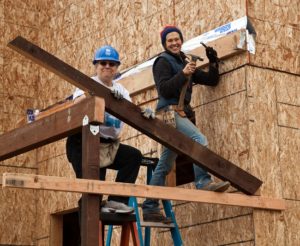
What does the new home construction process? Well, it depends on your specific situation, but there are ten steps that are always included.
The custom home building process is a rewarding one, but sometimes, it’s not always clear what that process looks like. While your builder is ultimately going to end up walking you through everything that goes down and will keep you updated along the way, part of being an educated consumer is doing a bit of research beforehand. Coming up with a proper breakdown of what new home construction looks like really depends on an individual instance, but we’ve outlined ten common steps that are a part of the home construction process, though they may not happen in this exact order.
1. Prepping the Site, Pouring Foundation
This is when the site is cleared with an excavator to get rid of any debris or trees. Space is also made for the septic system where applicable. The site is leveled and footers are dug to receive concrete as support for the house. Block is then laid and the foundation is ready for home construction to begin!
2. Rough Framing
Here is where the shell or skeleton of the house comes together. These are the basic floor, wall, and roof systems that are made of 2x material and oriented strand board. Then, sheathing is applied which gets covered with a protective barrier called a house wrap, which acts as a water barrier for the rough framing that has been put up.
3. Rough Plumbing, Electrical, HVAC
Now is when the basics of your utilities are installed. This , sewer lines, vents, water supply lines, bathtubs and shower units and ductwork for HVAC systems. HVAC and plumbing are important to get in before the wiring because wires are easier to work around pipes and ducts rather than vice versa.
4. Installing Insulation
Insulation is critical in the new home construction process, as it ultimately keeps you warm or cool regardless of the climate. There are a number of insulation materials used in homes like fiberglass, insulation concrete forms, spray foam, and more. A critical element of insulation is the R-value, which is a measurement of how well the material can resist heat transfer.
Drywall, Interior Textures
This is when walls begin to really come together. Drywall is hung and taped and any drywall texturing is finished. The primer coat of paint also goes down and exterior finishes like brick, stone, or siding are completed during this phase as well. Interior doors, baseboards, door casings, and more are all finished and walls get a fresh coat of paint or wallpaper.
6. Exterior Driveways and Walkways
Exterior driveways, walkways, or patios are formed at this stage. Sometimes, driveways aren’t poured until the end because other heavy equipment, like a drywall delivery vehicle, can end up damaging concrete or asphalt.
7. Hard-Surface Flooring & Countertops
Hard surfaces like ceramic tile, hardwood flooring, or vinyl get installed as well as cabinets and countertops.
8. Mechanical Trims, Bathroom Fixtures
Some of the little details like light fixtures, outlets, or switches get installed at this point and your electrical panel is completed as well. The rest of the HVAC equipment gets installed and finishing plumbing details like sinks or faucets are put in place.
9. Mirrors, Show Doors, Carpeting, and More
This is where everything finally comes together: mirrors, shower doors, and carpeting get put into place so your home feels finished. Exterior landscaping is also completed, meaning trees, shrubs, and grass are curated to look fresh.
10. Final Walkthrough
Finally, you’re going to do a walkthrough at the end of the building process to take a look at all of the features of your new home. You can take this opportunity to spot anything that needs to be corrected or fixed, so take the time to scrutinize everything and point out anything you may be concerned about.
Contact Accessible Home Builders Today
Here at Accessible Home Builders, we’re proud to say we’ve been building and remodeling homes since 1994. In that time, we’ve serviced the areas of Rehoboth Beach, Lewes, Selbyville, Seaford, Millsboro, Georgetown, Laurel, and more communities within Delaware. We work to guarantee a high level of professionalism, dedication, and the use of quality materials to ensure our customers have the home they deserve.
To get in touch with us, give us a call at our office at 302-663-0464, send us an email at info@accessiblehomebuilders.com or visit us in person at 28412 DuPont Blvd, #103 Millsboro, DE 19966. Alternatively, give our satellite office a call at 302-628-9571 which is located at 500 W. Stein Hwy. Seaford, DE 19973. Be sure to follow us on Facebook, Twitter, LinkedIn, and YouTube to stay updated on what we’re up to!



